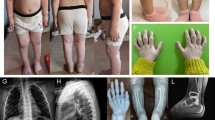Abstract
Vascular type of Ehlers–Danlos syndrome (EDS) is the most severe type of EDS. It is an autosomal dominantly inherited disorder that results from mutations within the α1 type III collagen gene (COL3A1). We report a novel point mutation at donor splice-site in intron 42 of type III collagen gene resulting in the inclusion of 30 nucleotides into the mature mRNA in a case of vascular type of EDS. Since the age of approximately 8 months, the patient had had repeated episodes of purpura and gradually developed thin, translucent skin. She had a past history of pneumothorax. At the initial examination, she was found to have the characteristic facies, i.e., bird-like face, of the vascular type of EDS, thinning of skin over the limbs and trunk, and scattered purpura. The blood vessels under the skin could be clearly visualized. She showed hypermobility of the small joints of all the four limbs and acrogeric changes of the hands and feet. Analysis of the amount of collagen synthesized from cultured dermal fibroblasts by SDS-polyacrylamide gel electrophoresis and fluorography was conducted based on the clinical suspicion of the vascular type of EDS, and a marked reduction in the synthesis of type III collagen was observed. Genetic analysis of the COL3A1 revealed a novel point mutation at the donor splice-site of intron 42, which resulted in the inclusion of 30 nucleotides into the mature mRNA of one allele.







Similar content being viewed by others
References
Beighton P, De Paepe A, Steinmann B, Tsipouras P, Westrup RJ (1998) Ehlers–Danlos syndrome: revised nosology, Villefranche. J Med Genet 77:31–37. doi:10.1002/(SICI)1096-8628(19980428)77:1<31::AID-AJMG8>3.0.CO;2-O
Dalgleish R (1998) The human collagen mutation database. Nucleic Acids Res 26:253–255. doi:10.1093/nar/26.1.253
Fleischmajer R, Perlish JS, Krieg T, Timple R (1981) Variability in collagen and fibronectin synthesis by scleroderma fibroblasts in primary culture. J Invest Dermatol 76:400–403. doi:10.1111/1523-1747.ep12520933
Giunta C, Steinmann B (2000) Characterization of 11 new mutations in COL3A1 of individuals with Ehlers–Danlos syndrome type IV: preliminary comparison of RNase cleavage, EMC and DHPLC assays. Hum Mutat 16:176–177. doi:10.1002/1098-1004(200008)16:2<176::AID-HUMU12>3.0.CO;2-E
Hata R, Kurata S, Shinkai H (1988) Existence of malfunctioning pro α2(I) collagen genes in a patient with a pro α2(I)-chain-defective variant of Ehlers–Danlos syndrome. Eur J Biochem 174:231–237. doi:10.1111/j.1432-1033.1988.tb14087.x
Hatamochi A, Ono M, Ueki H, Namba M (1991) Regulation of collagen gene expression by transformed human fibroblasts: decreased type I and type III collagen RNA transcription. J Invest Dermatol 96:473–477. doi:10.1111/1523-1747.ep12470171
Oderich GS, Pannecton JM, Bower NM, Bower TC, Lindor NM, Cherry KJ Jr, Noel AA, Kalra M, Sullivan T, Gloviczki P (2005) The spectrum, management and clinical outcome of Ehlers–Danlos syndrome type IV: a 30-year experience. J Vasc Surg 42:98–106. doi:10.1016/j.jvs.2005.03.053
Pepin M, Schwarze U, Superti-Furga A, Byers PH (2000) Clinical and genetic features of Ehlers–Danlos syndrome type IV, the vascular type. N Engl J Med 342:673–680. doi:10.1056/NEJM200003093421001
Pope FM, Narcisi P, Nicholis AC, Germaine D, Pals G, Richards AJ (1996) COL3A1 mutations cause variable clinical phenotypes including acrogeria and vascular rupture. Br J Dermatol 135:163–181. doi:10.1111/j.1365-2133.1996.tb01143.x
Schwarze U, Goldstein JA, Byers PH (1997) Splicing defects in the COL3A1 gene: marked preference for 5′(donor) splice-site mutations in patient with exon-skipping mutations and Ehlers–Danlos syndrome type IV. Am J Hum Genet 61:1276–1286. doi:10.1086/301641
Watanabe A, Kosho T, Wada T, Sakai N, Fujimoto M, Fukushima Y, Shimada T (2007) Genetic aspects of vascular type of Ehlers–Danlos syndrome(vEDS, EDSIV) in Japan. Circ J 71:261–265
Acknowledgments
We thank Miyuki Funakoshi and Takashi Namatame for their technical assistance.
Author information
Authors and Affiliations
Corresponding author
Rights and permissions
About this article
Cite this article
Okita, H., Ikeda, Y., Mitsuhashi, Y. et al. A novel point mutation at donor splice-site in intron 42 of type III collagen gene resulting in the inclusion of 30 nucleotides into the mature mRNA in a case of vascular type of Ehlers–Danlos syndrome. Arch Dermatol Res 302, 395–399 (2010). https://doi.org/10.1007/s00403-009-0970-6
Received:
Revised:
Accepted:
Published:
Issue Date:
DOI: https://doi.org/10.1007/s00403-009-0970-6




